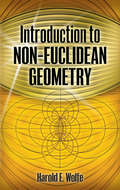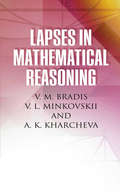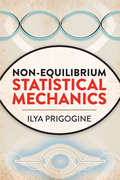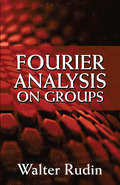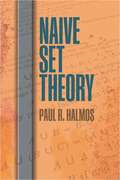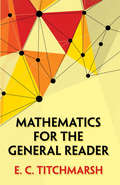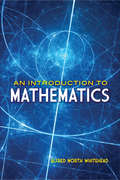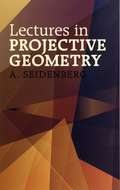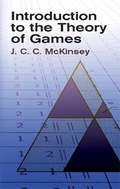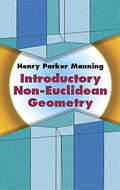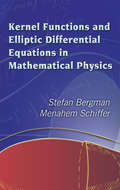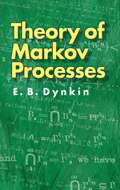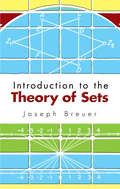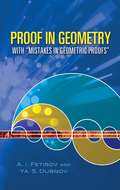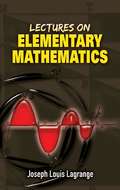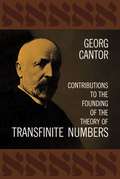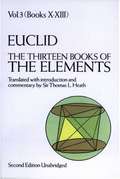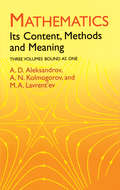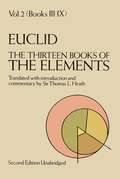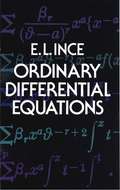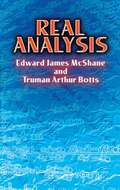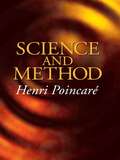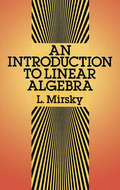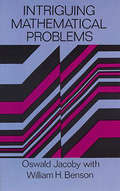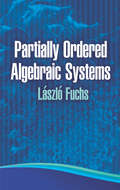- Table View
- List View
Introduction to Non-Euclidean Geometry (Dover Books on Mathematics)
by Harold E. WolfeOne of the first college-level texts for elementary courses in non-Euclidean geometry, this concise, readable volume is geared toward students familiar with calculus. A full treatment of the historical background explores the centuries-long efforts to prove Euclid's parallel postulate and their triumphant conclusion. Numerous original exercises form an integral part of the book.Topics include hyperbolic plane geometry and hyperbolic plane trigonometry, applications of calculus to the solutions of some problems in hyperbolic geometry, elliptic plane geometry and trigonometry, and the consistency of the non-Euclidean geometries. Extensive appendixes offer background information on the foundation of Euclidean geometry, circular and hyperbolic functions, the theory of orthogonal circles and allied topics, and the elements of inversion.
Lapses in Mathematical Reasoning (Dover Books on Mathematics)
by A. K. Kharcheva L. Minkovskii V. M. BradisDesigned as a method for teaching correct mathematical thinking to high school students, this book contains a brilliantly constructed series of what the authors call "lapses," erroneous statements that are part of a larger mathematical argument. These lapses lead to sophism or mathematical absurdities. The ingenious idea behind this technique is to lead the student deliberately toward a clearly false conclusion. The teacher and student then go back and analyze the lapse as a way to correct the problem.The authors begin by focusing on exercises in refuting erroneous mathematical arguments and their classification. The remaining chapters discuss examples of false arguments in arithmetic, algebra, geometry, trigonometry, and approximate computations. Ideally, students will come to the correct insights and conclusions on their own; however, each argument is followed by a detailed analysis of the false reasoning. Stimulating and unique, this book is an intriguing and enjoyable way to teach students critical mathematical reasoning skills.
Non-Equilibrium Statistical Mechanics (Dover Books On Physics Series)
by Ilya PrigogineIlya Prigogine won the 1977 Nobel Prize in Chemistry for his contributions to non-equilibrium thermodynamics. This groundbreaking 1962 monograph, written for researchers and graduate students in this field, was his first book-length contribution to this subject. Suitable for advanced undergraduates and graduate students in physics and chemistry, the treatment begins with examinations of the Liouville equation, anharmonic solids, and Brownian motion. Subsequent chapters explore weakly coupled gases, scattering theory and short-range forces, distribution functions and their diagrammatic representation, the time dependence of diagrams, the approach to equilibrium in ionized gases, and statistical hydrodynamics. Additional topics include general kinetic equations, general H-theorem, quantum mechanics, and irreversibility and invariants of motion. Appendices, a bibliography, list of symbols, and an index conclude the text.
Fourier Analysis on Groups (Dover Books on Mathematics)
by Walter RudinWritten by a master mathematical expositor, this classic text reflects the results of the intense period of research and development in the area of Fourier analysis in the decade preceding its first publication in 1962. The enduringly relevant treatment is geared toward advanced undergraduate and graduate students and has served as a fundamental resource for more than five decades.The self-contained text opens with an overview of the basic theorems of Fourier analysis and the structure of locally compact Abelian groups. Subsequent chapters explore idempotent measures, homomorphisms of group algebras, measures and Fourier transforms on thin sets, functions of Fourier transforms, closed ideals in L1(G), Fourier analysis on ordered groups, and closed subalgebras of L1(G). Helpful Appendixes contain background information on topology and topological groups, Banach spaces and algebras, and measure theory.
Naive Set Theory (Dover Books on Mathematics)
by Paul R. HalmosThis classic by one of the twentieth century's most prominent mathematicians offers a concise introduction to set theory. Suitable for advanced undergraduates and graduate students in mathematics, it employs the language and notation of informal mathematics. There are very few displayed theorems; most of the facts are stated in simple terms, followed by a sketch of the proof. Only a few exercises are designated as such since the book itself is an ongoing series of exercises with hints. The treatment covers the basic concepts of set theory, cardinal numbers, transfinite methods, and a good deal more in 25 brief chapters.
Mathematics for the General Reader (Dover Books on Mathematics)
by E. C. TitchmarshThis highly accessible introduction to mathematics is geared toward readers seeking a firm grasp of the essentials of mathematical theory and practice. The treatment also offers a concise outline of mathematical history and a clearer notion of why mathematicians do what they do.Author E. C. Titchmarsh, who served for many years as Savilian Professor of Geometry at Oxford University, begins with counting and the fundamentals of arithmetic. He guides readers through the complexities of algebra, fractions, geometry, irrational numbers, logarithms, infinite series, complex numbers, quadratic equations, trigonometry, functions, and integral and differential calculus. Titchmarsh's graceful, fluid style helps make complicated topics easier to grasp, and his inclusion of numerous examples will prove especially helpful to readers with little or no background in mathematics.
An Introduction to Mathematics (Dover Books on Mathematics)
by Alfred North Whitehead"The object of the following chapters is not to teach mathematics, but to enable students from the very beginning of their course to know what the science is about, and why it is necessarily the foundation of exact thought as applied to natural phenomena." Thus begins this volume by the prominent English philosopher and mathematician Alfred North Whitehead, a concise statement on the nature and meaning of mathematics for the general student. Expertly written and abounding in insights, the book presents a lively exposition of mathematical concepts, the history of their development, and their applications to the physical world. Whitehead explains in broad terms what mathematics is about, what it does, and how mathematicians do it.Generations of readers who have stayed with the philosopher from the beginning to the end have found themselves amply rewarded for taking this journey.
Lectures in Projective Geometry (Dover Books on Mathematics)
by A. SeidenbergAn ideal text for undergraduate courses in projective geometry, this volume begins on familiar ground. It starts by employing the leading methods of projective geometry as an extension of high school-level studies of geometry and algebra, and proceeds to more advanced topics with an axiomatic approach.An introductory chapter leads to discussions of projective geometry's axiomatic foundations: establishing coordinates in a plane; relations between the basic theorems; higher-dimensional space; and conics. Additional topics include coordinate systems and linear transformations; an abstract consideration of coordinate systems; an analytical treatment of conic sections; coordinates on a conic; pairs of conics; quadric surfaces; and the Jordan canonical form. Numerous figures illuminate the text.
Introduction to the Theory of Games (Dover Books on Mathematics)
by J. C. McKinseyOne of the classic early monographs on game theory, this comprehensive overview illustrates the theory's applications to situations involving conflicts of interest, including economic, social, political, and military contexts. Contents include a survey of rectangular games; a method of approximating the value of a game; games in extensive form and those with infinite strategies; distribution functions; Stieltjes integrals; the fundamental theorem for continuous games; separable games; games with convex payoff functions; applications to statistical inference; and much more. Appropriate for advanced undergraduate and graduate courses; a familiarity with advanced calculus is assumed. 1952 edition. 51 figures. 8 tables.
Introductory Non-Euclidean Geometry (Dover Books on Mathematics)
by Henry Parker ManningThis fine and versatile introduction to non-Euclidean geometry is appropriate for both high-school and college classes. Its first two-thirds requires just a familiarity with plane and solid geometry and trigonometry, and calculus is employed only in the final part. It begins with the theorems common to Euclidean and non-Euclidean geometry, and then it addresses the specific differences that constitute elliptic and hyperbolic geometry. Major topics include hyperbolic geometry, single elliptic geometry, and analytic non-Euclidean geometry. 1901 edition.
Kernel Functions and Elliptic Differential Equations in Mathematical Physics (Dover Books on Mathematics #Volume 4)
by Stefan Bergman Menahem SchifferThis text focuses on the theory of boundary value problems in partial differential equations, which plays a central role in various fields of pure and applied mathematics, theoretical physics, and engineering. Geared toward upper-level undergraduates and graduate students, it discusses a portion of the theory from a unifying point of view and provides a systematic and self-contained introduction to each branch of the applications it employs.The two-part treatment begins with a survey of boundary value problems occurring in certain branches of theoretical physics. It introduces fundamental solutions in a heuristic way and examines their physical significance. Many concepts can be unified by concentrating upon these particular kernels, and the text explains the common mathematical background of widely varying theories, such as those of heat conduction, hydrodynamics, electrostatics, magnetostatics, and elasticity. In addition to its intrinsic interest, this material provides illustrations and exact mathematical formulation of the problems and the methods. The second part is confined to a rather special type of partial differential equation, which is dealt with in the greatest detail so that students can make applications and generalizations to similar problems.
Theory of Markov Processes (Dover Books on Mathematics)
by E. B. Dynkin D. E. Brown T. KovaryAn investigation of the logical foundations of the theory behind Markov random processes, this text explores subprocesses, transition functions, and conditions for boundedness and continuity. Rather than focusing on probability measures individually, the work explores connections between functions. An elementary grasp of the theory of Markov processes is assumed.Starting with a brief survey of relevant concepts and theorems from measure theory, the text investigates operations that permit an inspection of the class of Markov processes corresponding to a given transition function. It advances to the more complicated operations of generating a subprocess, followed by examinations of the construction of Markov processes with given transition functions, the concept of a strictly "Markov process," and the conditions required for boundedness and continuity of a Markov process. Addenda, notes, references, and indexes supplement the text.
Introduction to the Theory of Sets (Dover Books on Mathematics)
by Joseph Breuer Howard F. FehrSet theory permeates much of contemporary mathematical thought. This text for undergraduates offers a natural introduction, developing the subject through observations of the physical world. Its progressive development leads from concrete finite sets to cardinal numbers, infinite cardinals, and ordinals.Although set theory begins in the intuitive and the concrete, it ascends to a very high degree of abstraction. All that is necessary to its grasp, declares author Joseph Breuer, is patience. Breuer illustrates the grounding of finite sets in arithmetic, permutations, and combinations, which provides the terminology and symbolism for further study. Discussions of general theory lead to a study of ordered sets, concluding with a look at the paradoxes of set theory and the nature of formalism and intuitionalism. Answers to exercises incorporated throughout the text appear at the end, along with an appendix featuring glossaries and other helpful information.
Proof in Geometry: With "Mistakes in Geometric Proofs" (Dover Books on Mathematics)
by A. I. Fetisov Ya. S. DubnovThis single-volume compilation of two books explores the construction of geometric proofs. In addition to offering useful criteria for determining correctness, it presents examples of faulty proofs that illustrate common errors. High-school geometry is the sole prerequisite.Proof in Geometry, the first in this two-part compilation, discusses the construction of geometric proofs and presents criteria useful for determining whether a proof is logically correct and whether it actually constitutes proof. It features sample invalid proofs, in which the errors are explained and corrected.Mistakes in Geometric Proofs, the second book in this compilation, consists chiefly of examples of faulty proofs. Some illustrate mistakes in reasoning students might be likely to make, and others are classic sophisms. Chapters 1 and 3 present the faulty proofs, and chapters 2 and 4 offer comprehensive analyses of the errors.
Lectures on Elementary Mathematics (Dover Books on Mathematics)
by Joseph Louis LagrangeOne of the eighteenth century's greatest mathematicians, Lagrange made significant contributions to all fields of analysis and number theory. He survived the French Revolution to deliver these lectures in 1795 at the École Normale, a training school for teachers. An exemplar among elementary expositions, Lagrange's talks feature both originality of thought and elegance of expression.The five lectures begin with discussions of arithmetic that focus on fractions and logarithms as well as theory and applications. Subsequent talks consider algebra, with emphasis on the resolution of equations of the third and fourth degree, the resolution of numerical equations, and the employment of curves in the solution of problems. Students, teachers, and others with an interest in mathematics will find this volume a unique reading book in mathematics, with fascinating historical and philosophical remarks by a distinguished mathematician.
Contributions to the Founding of the Theory of Transfinite Numbers (Dover Books on Mathematics)
by Georg CantorOne of the greatest mathematical classics of all time, this work established a new field of mathematics which was to be of incalculable importance in topology, number theory, analysis, theory of functions, etc., as well as in the entire field of modern logic. It is rare that a theory of such fundamental mathematical importance is expressed so simply and clearly: the reader with a good grasp of college mathematics will be able to understand most of the basic ideas and many of the proofs.Cantor first develops the elementary definitions and operations of cardinal and ordinal numbers and analyzes the concepts of "canlinality" and "ordinality." He covers such topics as the addition, multiplication, and exponentiation of cardinal numbers, the smallest transfinite cardinal number, the ordinal types of simply ordered aggregates, operations on ordinal types, the ordinal type of the linear continuum, and others. He then develops a theory of well-ordered aggregates, and investigates the ordinal numbers of well-ordered aggregates and the properties and extent of the transfinite ordinal numbers.An 82-page introduction by the eminent mathematical historian Philip E. B. Jourdain first sketches the background of Cantor's theory, discussing the contributions of such predecessors as Veicrstrass, Cauchy, Dedekind, Dirichlet, Riemann, Fourier, and Hankel; it then traces the development of the theory by summarizing and analyzing Cantor's earlier work. A bibliographical note provides information on further investigations in the theory of transfinite numbers by Frege, Peano, Whitehead, Russell, etc.
The Thirteen Books of the Elements, Vol. 3 (Dover Books on Mathematics #3)
by EuclidThis is the definitive edition of one of the very greatest classics of all time—the full Euclid, not an abridgement. Utilizing the text established by Heiberg, Sir Thomas Heath encompasses almost 2500 years of mathematical and historical study upon Euclid.This unabridged republication of the original enlarged edition contains the complete English text of all 13 books of the Elements, plus a critical apparatus which analyzes each definition, postulate, and proposition in great detail. It covers textual and linguistic matters; mathematical anayses of Euclid's ideas; classical, medieval, Renaissance, modern commentators; refutations, supports, extrapolations, reinterpretations, and historical notes, all given with extensive quotes.
Mathematics: Its Content, Methods and Meaning (Dover Books on Mathematics)
by A. N. Kolmogorov A. D. Aleksandrov M. A. Lavrent’evThis major survey of mathematics, featuring the work of 18 outstanding Russian mathematicians and including material on both elementary and advanced levels, encompasses 20 prime subject areas in mathematics in terms of their simple origins and their subsequent sophisticated developement. As Professor Morris Kline of New York University noted, "This unique work presents the amazing panorama of mathematics proper. It is the best answer in print to what mathematics contains both on the elementary and advanced levels."Beginning with an overview and analysis of mathematics, the first of three major divisions of the book progresses to an exploration of analytic geometry, algebra, and ordinary differential equations. The second part introduces partial differential equations, along with theories of curves and surfaces, the calculus of variations, and functions of a complex variable. It furthur examines prime numbers, the theory of probability, approximations, and the role of computers in mathematics. The theory of functions of a real variable opens the final section, followed by discussions of linear algebra and nonEuclidian geometry, topology, functional analysis, and groups and other algebraic systems.Thorough, coherent explanations of each topic are further augumented by numerous illustrative figures, and every chapter concludes with a suggested reading list. Formerly issued as a three-volume set, this mathematical masterpiece is now available in a convenient and modestly priced one-volume edition, perfect for study or reference.
The Thirteen Books of the Elements: Books Iii-ix (classic Reprint) (Dover Books on Mathematics #2)
by EuclidThis is the definitive edition of one of the very greatest classics of all time — the full Euclid, not an abridgement. Using the text established by Heiberg, Sir Thomas Heath encompasses almost 2,500 years of mathematical and historical study upon Euclid.This unabridged republication of the original enlarged edition contains the complete English text of all 13 books of the Elements, plus a critical apparatus that analyzes each definition, postulate, and proposition in great detail. It covers textual and linguistic matters; mathematical analyses of Euclid’s ideas; classical, medieval, Renaissance, modern commentators; refutations, supports, extrapolations, reinterpretations, and historical notes, all given with extensive quotes. Volume 1. 151-page Introduction: life and other works of Euclid; Greek and Islamic commentators; surviving mss., scholia, translations; bases of Euclid’s thought. Books I and II of the Elements, straight lines, angles, intersection of lines, triangles, parallelograms, etc.Volume 2. Books III-IX: Circles, tangents, segments, figures described around and within circles, rations, proportions, magnitudes, polygons, prime numbers, products, plane and solid numbers, series of rations, etc.Volume 3. Books X to XIII: planes, solid angles, etc.; method of exhaustion in similar polygons within circles, pyramids, cones, cylinders, spheres, etc. Appendix: Books XIV, XV, sometimes ascribed to Euclid.
Ordinary Differential Equations (Dover Books on Mathematics)
by Edward L. InceThe theory of ordinary differential equations in real and complex domains is here clearly explained and analyzed. Not only classical theory, but also the main developments of modern times are covered. Exhaustive sections on the existence and nature of solutions, continuous transformation groups, the algebraic theory of linear differential systems, and the solution of differential equations by contour integration are as valuable to the pure mathematician as the fine treatment of the equations of Legendre, Bessel, and Mathieu, the conditions for the oscillatory character of solutions of a differential equation, and the relation between a linear differential system and an integral equation are to the engineer and the physicist.Partial contents: real domain (elementary methods of integration, the existence and nature of solutions, continuous transformation-groups, linear differential equations-the general theory, with constant coefficients, solutions, algebraic theory, Sturmian theory, and later developments); complex domain (existence theorems, equations of first order, non-linear equations of higher order, solutions, systems, classifications of linear equations, oscillation theorems).
Real Analysis
by Truman Arthur Botts Edward James McShaneThis text offers upper-level undergraduates and graduate students a survey of practical elements of real function theory, general topology, and functional analysis. Beginning with a brief discussion of proof and definition by mathematical induction, it freely uses these notions and techniques. The maximality principle is introduced early but used sparingly; an appendix provides a more thorough treatment. The notion of convergence is stated in basic form and presented initially in a general setting. The Lebesgue-Stieltjes integral is introduced in terms of the ideas of Daniell, measure-theoretic considerations playing only a secondary part. The final chapter, on function spaces and harmonic analysis, is deliberately accelerated. Helpful exercises appear throughout the text. 1959 edition.
Science and Method
by Henri PoincaréThis classic by the famous mathematician defines the basic methodology and psychology of scientific discovery, particularly regarding mathematics and mathematical physics. Drawing on examples from many fields, it explains how scientists analyze and choose their working facts, and it explores the nature of experimentation, theory, and the mind. 1914 edition.
An Introduction to Linear Algebra (Dover Books on Mathematics)
by L. MirskyThis work provides an elementary and easily readable account of linear algebra, in which the exposition is sufficiently simple to make it equally useful to readers whose principal interests lie in the fields of physics or technology. The account is self-contained, and the reader is not assumed to have any previous knowledge of linear algebra. Although its accessibility makes it suitable for non-mathematicians, Professor Mirsky's book is nevertheless a systematic and rigorous development of the subject. Part I deals with determinants, vector spaces, matrices, linear equations, and the representation of linear operators by matrices. Part II begins with the introduction of the characteristic equation and goes on to discuss unitary matrices, linear groups, functions of matrices, and diagonal and triangular canonical forms. Part II is concerned with quadratic forms and related concepts. Applications to geometry are stressed throughout; and such topics as rotation, reduction of quadrics to principal axes, and classification of quadrics are treated in some detail. An account of most of the elementary inequalities arising in the theory of matrices is also included. Among the most valuable features of the book are the numerous examples and problems at the end of each chapter, carefully selected to clarify points made in the text.
Intriguing Mathematical Problems (Dover Books on Mathematics)
by Oswald Jacoby William H. BensonAmusing and informative in its approach to solving mathematical bafflers, this treasury of theories, games, puzzles and oddities of all kinds, compiled by one of the world's best card players (Jacoby) and an expert in mathematical recreations (Benson) will delight and fascinate math enthusiasts.Although primarily intended to entertain, the wide variety of puzzles ― ranging from facile curiosities to very difficult intellectual exercises ― will challenge you to keep your mind going full steam. Each of the book's five sections ― "Fun with Numbers," "Fun with Letters," "The Odds: Explorations in Probability," "Where Inference and Reasoning Reign" and "The Answers Are Whole Numbers" ― is made up of approximately 30 problems, with solutions grouped at the end of each section. Math buffs will love testing their puzzle-solving skills on such challenging brainteasers as The Enterprising Snail, Mrs. Crabbe and the Bacon, The Fly and the Bicycles, The Lovesick Cockroaches, The Three Prisoners, Girls Should Live in Brooklyn, Who Was Executed?, Creaker vs. Roadhog, The Crossed Ladders, The Ancient Order of the Greens, and many more.Few of these problems require any advanced mathematical knowledge or prowess. You'll find that simply keeping your wits about you and your logical skills honed are all you need to enjoy a delightful and thought-provoking adventure in recreational mathematics. Foreword. 10 illustrations. 14 tables.
Partially Ordered Algebraic Systems (Dover Books on Mathematics)
by Laszlo FuchsOriginally published in an important series of books on pure and applied mathematics, this monograph by a distinguished mathematician explores a high-level area in algebra. It constitutes the first systematic summary of research concerning partially ordered groups, semigroups, rings, and fields. The self-contained treatment features numerous problems, complete proofs, a detailed bibliography, and indexes. It presumes some knowledge of abstract algebra, providing necessary background and references where appropriate. This inexpensive edition of a hard-to-find systematic survey will fill a gap in many individual and institutional libraries.
